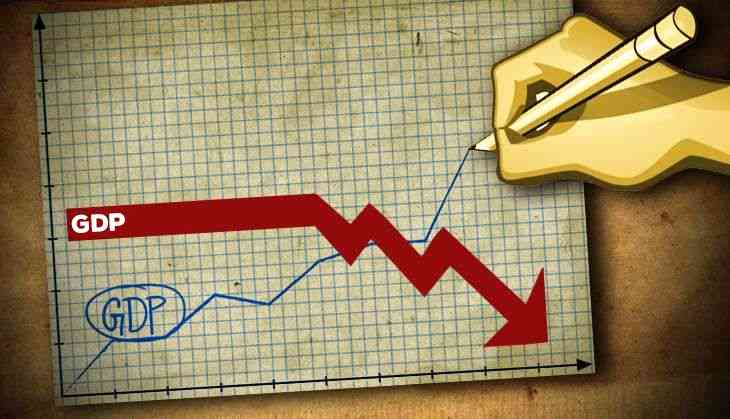The story in the GDP numbers that the govt doesn't want you to know

With the Narendra Modi-government going gung-ho over the latest gross domestic product (GDP) figures, there is a need to look at the data more closely. The government's celebrations are solely based on the spurt in GDP growth rate from the first quarter of the current fiscal to the second quarter. Many other sub-texts are being ignored.
Finance minister Arun Jaitley told the press he was happy to note that “the deceleration trend in overall growth, which was witnessed since the First Quarter of last Fiscal Year, has been now reversed”. The real GDP growth in the second quarter of the current fiscal has been estimated at 6.3%, as compared to 5.7% in the first quarter.
Real gross value added (GVA) growth has also shown a similar hike to 6.1% in the second quarter from 5.6% in the first. Jaitley said this indicates that the economy has left behind the impact of demonetisation and Goods and Services Tax (GST). Catch spoke to various economists to get a sense of their assessment of the data and the government's interpretation of it.
Not a real picture
Former chief statistician of India, Prof Pronab Sen, told Catch that it is hard to draw any conclusions from this data because the economy is experiencing fluctuations right now and the full impact of these fluctuations will be known only after things have settled. He stressed that for that, we will have to look at the next two quarters.
Sen also pointed out that that GST's impact was on trade and we used to estimate the state of the trade sector through sales tax collections. However, with GST having replaced sales tax, it will be impossible to estimate the performance of trade before the final picture on GST collections is clear.
Prof Arun Kumar, Malcolm Adiseshiah Chair Professor at Institute of Social Sciences, said GDP data in any case is not equipped to assess the impact of demonetisation because that impact was mostly in the unorganised sector. The GDP data, he explained, looks only at the organised sector, which contributes to 55% of the GDP. In fact, he added, it looks only at the corporate sector within the organised sector.
Kumar stressed that, therefore, what is needed is a comprehensive and timely survey of the performance of the unorganised sector since demonetisation and only that will be able to show the real picture.
Swaminathan Aiyar, well-known journalist and commentator on economic issues, also highlighted that the sector that was doubly hit by demonetisation and GST was the small industries sector. So, to assess whether the economy has actually left behind the shock induced by the two measures, data on the small industries will need to be looked at, he added.
On their own, Aiyar said, these numbers indicate that the economy seems to be bottoming out, but then it is a very low bottom.
Jaitley had also said that the acceleration in growth has been “helped by a rapid growth in manufacturing”. The sector has shown growth of 7% in the second quarter from 1.2% in the first quarter. However, Sen explained there was nothing extraordinary about it because the first quarter saw de-stocking of all pre-GST inventory and the second quarter only compensated for that through re-stocking.
Interestingly, leaders of the Opposition have pointed out that this quarter to quarter comparison hides the real picture, because in the same quarter last year, GDP growth was 7.5%. That actually means a fall of 1.2%.
Last year Q2 GDP growth was 7.5% and this year it is 6.3%. This Govt only bhashan, no action
— Mamata Banerjee (@MamataOfficial) November 30, 2017
However, Kumar said this year on year comparison wouldn't hold for for 2017 because demonetisation was a shock measure that broke the continuity in calculation.
The depressing aspect of the GDP data has been agriculture's performance. The farm sector grew 1.7% in the September quarter, slower than the previous quarter’s 2.3%. CPI(M)'s Sitaram Yechury said that the data highlighted the crisis in the farm sector and exposed the government's claims of trying to double farm income.
GDP data shows the crisis in the farm sector. Instead of Jumlas about doubling farmers’ income by 2022, this govt should tell us what steps it plans to take to ease farmers’, their families’ pain and give them their rightful due. https://t.co/OFMpsq79Nq
— Sitaram Yechury (@SitaramYechury) December 1, 2017
However, Sen says that while the crisis of agriculture is an accepted phenomenon, this data itself doesn't indicate any particular aggravation. He said his own estimation was 2% for the sector for this quarter, so the final result is more on expected lines.
There are other ways to look at it too. Agriculture expert Devinder Sharma is opposed to the very calculation of agriculture GDP on a quarterly basis.
Measuring Agriculture GDP on a quarterly basis is not economics. There is no way you can measure farm growth like this. Crops have their own growing season, which does not conform to any of the 4 quarters for which GDP is calculated.
— Devinder Sharma (@Devinder_Sharma) December 1, 2017
To sum it up, it looks like that the government will find it hard to convince everybody that this temporary uptick is a firm indicator of the economy emerging out of the woods yet. Only a full-fledged study of the unorganised sector will fully examine the impact of GST and demonetisation.
First published: 1 December 2017, 21:11 IST

